Brandon
in 1881
A
Month-by-Month
look at the Brandon's Early Days
Based on the News Reports of the day.
It is interesting to note that the comings
and
goings of our frontier
predecessors
were chronicled by quite a variety of North
American
papers:
The Winnipeg Time (WT)
The Winnipeg Daily Sun WDS)
The Brandon Sun Weekly (BSW)
The Portage La Prairie Weekly (PLP)
The Minnedosa Tribune (MT)
Quebec Daily Evening Mercury (QDM)
Montreal Daily Witness (MDW)
Ottawa Daily Telegraph (ODT)
Toronto Daily Mail (TDM)
Providence Journal (PJ)
Ottawa Daily Free Press (ODF
The Nation (Nat)
and even..
The New York Times (NYT)
View the Newspaper
Clippings

Introduction
Although its been but
a
short while since Brandon celebrated the 125th
anniversary of its incorporation as a city (2007) the spring of 2011
has brought
another anniversary of sorts. Brandon is somewhat famous for
having almost skipped the "town" phase and going directly to city
status in 1882 slightly more than a year after the first buildings were
erected. So while we measure Brandon's existence as a city from
1882 Brandon's real beginning was in 1881and
if there is one month of the year that is especially significant to
Brandon's appearance on the map, it would be the month of May. On May
1st, of 1881 no one lived here and the end of that month dozens
of businesses had been
established, many in tents, and it was already a bustling place.
A busy month
indeed.
Not only did Brandon
spring
up quickly, it seems its appearance was
genuinely unanticipated - no one saw it coming. Elsewhere across the
province speculative or "paper" citys were
everywhere. With names like "Souris City", "Manitoba City",
Dobbyn City" and yes, even "Rapid City", there was no shortage of
contestants for the title "Next Great City of the West". The
years 1881 and 1882 are known as the "Manitoba Boom" and fortunes were
made and lost in selling real estate, largely in the form of lots in
these would-be cities. (1)
 7-April
1881, Winnipeg Times
7-April
1881, Winnipeg Times
Meanwhile, in the
winter of
1880-81, the site of Brandon lay idle, its
very sod unbroken, not a building in site. To the north Rapid City had
already experienced its first boom as investors were sure that the
C.P.R.
would pass that way. It remained the only real town in the area.
A
few miles downriver from our current city William Currie had settled on
a farm that straddled the river at the foot of the Brandon Rapids (then
called the Grand Rapids) . He soon had a ferry crossing
and steamboat landing that became the jumping-off point for
settlers heading the bustling Rapid City Settlement. (2) Though
locally
known as Currie's Landing it was also called Rapid City Landing
as
well. A Post Office and store a few kilometres east known
as Grand Valley was another sign of settlement, it took soon had a
warehouse and landing.
Early in the spring when rumours began to circulate that the
transcontinental railway, instead of following the expected, more
northerly route, might cross the Assiniboine nearby, and strike a more
southerly trail towards the coast, it began to appear
that the little settlement at Grand Valley might be destined for
greater
things. It became a place to watch (and an investment opportunity!),
while the site of Brandon attracted only a would-be homesteader who
hadn't yet bothered to build and plant.
Of course the name
Brandon
had been associated with this region for
decades. A Hudson's Bay Co. Fur Trade Post named Brandon House was
established before 1800 near Treesbank. The range of hills to the
south of our city, previously the Moose Head Hills, began to be called
the Brandon Hills some time after the Fur Trade Posts appeared. A Post
Office called Brandon was opened in the area we know know as Brandon
Hills after the a groups of Nova Scotians settled there in 1879.
So, with an eye on the the upcoming anniversary of this busy month, and
the
busy year that followed, I'd like to introduce a month-by month account
of the happenings as they occurred 130 years ago. In doing so I have to
say a word about my main sources. Today's online newspaper
archives have made it much easier for the historian to get a feel
for day-to-day life in pioneer times. I invite everyone do some
looking themselves at Manitobia.ca, PaperofRecord.com
and Google News, and I propose to accompany this series with a
website with a complete set of the clippings I am using.
That said, let's first begin by setting
the stage. To fully appreciate the events of May in 1881 we have to
look back a bit. Not too far however. Lets start with a look at 1879.

1879
If one does a search
for
Brandon, Manitoba, in the newspapers of 1879 it comes up blank. Not
only did in not yet exist, but this bit of
geography we call home wasn't yet in Manitoba. Until the boundary
of the "Postage Stamp Province" was extended
westward in 1881, the region's settlements were in the Northwest
Territories.
The press however did take note of the important
happenings
in our area. And there were things happening. For instance on June
11, 1879 the Toronto Daily Mail reported that improved river transport
would soon make it easier for immigrants to, "be provided with though
tickets right to the Little Sasktachewan and to Fort Ellis (sic)"
(1) The report
goes on the recognize
that the river route will cut travel times, between Winnipeg and
the Saskatchewan River from eight days to three.
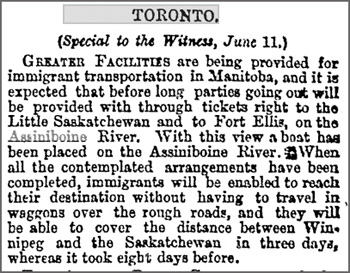 11-June,
1879 -
Toronto
Daily Mail
11-June,
1879 -
Toronto
Daily Mail
In 1879 there was a lot of talk in Ontario
about the "Great Lone Land"
as described by William Butler in his recent book about the west.
Settlers were beginning to trickle into this new land but they really
were on the frontier. Supply posts were primarily the long-established
Hudson's Bay Posts such as Fort Ellice, and these were few and far
between. Numerous posts such as Brandon House - had closed as first
the fur-bearing animals, and more recently, buffalo, had almost
disappeared
from the plains. The other main news from the frontier was the
ongoing saga of the long promised trans-continental railway.
A long and detailed article in the Montreal Gazette in the summer of
1879 outlines the progress and plans of this project. The big news was
that a new route was being planned. The first proposed route
would have seen the railway cross the Red River at Selkirk and proceed
north west through the narrows of Lake Manitoba, through the Swan River
Valley, and towards Edmonton. Now, the plan was to go by way of
Portage,
Fort Ellice, and then towards Edmonton. One effect of the plan was
to prompt a fair share of the new settlers to search for land that
would be close to this route, and to avoid even good farm land that was
far from it. This helps explain why the first notable settlements in
western Manitoba evolved to to the north of Brandon.
But there were a few hardy souls in the neighbourhood. Another article
from 1879, this one in the Ottawa Daily Witness, in a report based more
on gossip than on fact, reported that,"This morning's telegrams from
Winnipeg state that immense beds of coal have been discovered on the
River Assiniboine, about sixty miles south of Grand Valley...". (3) It goes
on to mistakenly report that this is puzzling because, "Grand Valley is
ten miles south of the Assiniboine." and assumes that the informant is
thinking of the coal beds known to be on the Souris at Beinfait
in southeastern Saskatchewan. Who knows what the truth of the whole
matter was but the article is an excellent reminder of the shortage of
hard
facts in reporting about the frontier. There was indeed some talk of
coal in the Turtle Mountain area and there were some early attempts at
settlement of that region. Grand Valley certainly was on the
Assiniboine, perhaps again the original reported confuse that with the
Roddick or Nova Scotia settlement in the Brandon Hills. Aside
from learning to beware of newspaper reports the only thing we can
learn from this article is that a place called Grand Valley seems to
have been put on the map.
Anyone driving east of Brandon on Veteran's Way will pass by a
relatively unobtrusive cairn a few kilometres east of First
Street. This is the site of Grand Valley. It was at a convenient
crossing point and home to the first post office south of Rapid City.
For a short period of time (less than two years) it was quite an
important spot, especially as a drop off point for frieght shipped by
steamboat to places like Rapid City. If and when a railway arrived it
would be the logical place to erect a station and build a town.
To get a more reliable picture of the general pattern of settlement in
western Manitoba one need only look at the routine publication of Mail
Routes and Schedules. An entry entitled "Western Mails" shows us that
Grand Valley was indeed on the map and receiving mail service in 1879,
on a route that included the more well established village of Rapid
City. (4)
So as we approach that hectic period, 130 years ago, we see that
conventional thinking in 1879 wouldn't have predicted that in less than
two years the new town of Brandon would appear overnight and within
days this unanticipated collection of hastily erected commercial
buildings would become the most important place on the prairies west of
Winnipeg.

1880
The summer of
1880 saw
quite an upswing in activity in the neighbourhood of the future city of
Brandon and the Winnipeg newspapers did take an
increasing interest in the happenings
in our area. For instance on April
16, 1880 the Winnipeg Times reported that "A ferry has been established
at the Grand Valley crossing of the Assiniboine River. This will give
people visiting the Souris country from the north shore better
travelling facilities. Another ferry is projected at Brandon crossing
15 miles further down the river." (1)
This is a very informative little article. It seems to indicate that
the
importance of the Grand Valley location was it offered
access to the regions to the south were settlements near the mouth of
the Souris, and in the Turtle Mountains, were just beginning. That is
not to say Grand Valley
wasn't a destination in and of itself. It was the first post office in
the area, and the McVicars, who first appeared in 1878 had established
a river crossing, a steamboat landing and eventually some warehouse
buildings to facilitate its role as a river port. But that was
about it. The article also reminds us that although the
name Brandon appears, its use bears no relationship to the site of the
current city. The projected "Brandon crossing" ferry sight would in
fact close to the
location of the former fur trade posts at Souris and near the already
established town of Millford. If the term was used in reference to a
community, that community would be Brandon Hills settlement.
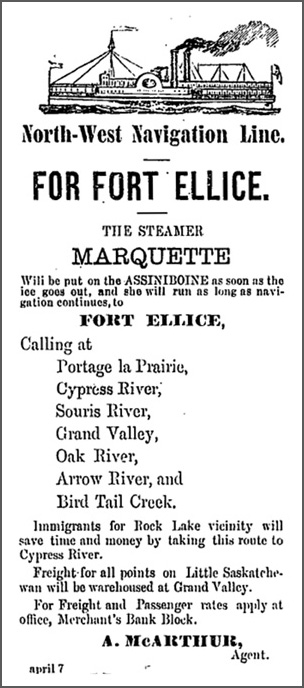 7-May,
1880 -
Winnipeg
Times
7-May,
1880 -
Winnipeg
Times
The advertising in old
newpapers is also a valuable source of
information. A large display ad for the North-West Navigation Line
which ran in the Winnipeg Times throughout April informs us that the
"Steamer Marquette will be put on the Assiniboine as soon as the ice
goes out.." (2) The
destination listed is Fort Ellice (an H.B.C. Post near
St. Lazarre) with stops at: "Portage la Prairie, Cypress River, Souris
River, Grand Valley, Oak River, Arrow River and Bird Tail Creek." It
reminds us that "Freight for all points on the Little Saskatchewan
(such as Rapid City and Minnedosa) will be warehoused at Grand
Valley."
The ad reminds us that in the
pre-settlement days place names had flexible meanings. A place didn't
need to be a "town" in the sense that we know it to be on the map.
Indeed in the sparsely settled land that we now call home, towns and
villages were of little consequence. There weren't enough farms,
therefore, enough commerce, to justify them. Portage la Prairie was a
town, indeed an important one. Cypress River, Souris River, Oak River,
Arrow River and Birdtail Creek were not towns but landings named
after streams entering the Assiniboine. (Cypress River, Oak River and
Arrow River would later come to identify towns, but in
each case many kilometres from the river landings.) In the case of
Grand
Valley, although
it later aspired to being a town, it was, as we see, essentially a
landing - a stop on a route. Which brings us to another thing about
place names on the frontier. If
a newspaper report that someone was going to locate at Grand Valley
they general meant Grand Valley, the region, the area, and
sometimes, literally, the valley.
Another informative
story, from May 17 tells us of a party of 60
immigrants brought to Rapid City as part of an organized colonization
program. It reminds us the Rapid City was expected to be the commercial
centre of the region. It mentions that, "They will leave by the
Assiniboine boat ...for Rapid City Landing." (3) The
importance of the
landings at both Currie's and Grand Valley is reflected by the name
used. They were seen as waypoints rather than destinations. Another
report from May 9 mentions Rapid City Landing as a destination
for the steamer Minnesota, (4) while an
August 18 ad has the Marquette
heading for "Curries Landing" (5) - the same place
by another name. One
notes that the trips in the summer months didn't go past the Brandon
Rapids, while the springtime trips went as far as Fort Ellice, and its
easy to see why river transportation so quickly disappeared when the
ever more reliable trains arrived.
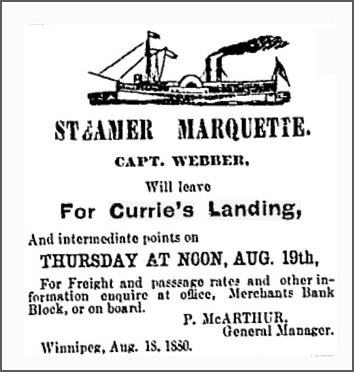 18-August,
1880 -
Winnipeg Times
18-August,
1880 -
Winnipeg Times
In searching through
old
newspapers it becomes apparent that news from
the frontier slowed to a trickle in the winter. Traveling was not
advised, or shall we
say, barely possible. All that changed when the ice left the
rivers.
May was an especially busy month as settlers took advantage of the
river boats to move themselves an goods onto homesteads. What we
can ascertain from glancing through the news of the day is that things
were happening in this region, things that would mark the beginning of
a great wave of
settlement that in ten short years would change the face of the the
region. People were starting to arrive and big plans were being made,
but the future city of Brandon was not on the drawing board.

Winter 1880 - 81
On January 6, 1881,
The
Winnipeg Times reprinted a Letter to the Editor
from the Montreal Witness about, "an educational institution recently
established in Rapid City." The letter outlines the reason for the
establishment of said institution: "allow young settlers
(men) to receive a good mental training" and to be "brought under the
influence of the gospel." (1) The
efforts of these young men of
Rapid City toward the erection of a suitable building are detailed and
the letter ends in a plea for funds. The letter is notable for
two reasons. Once again we witness the pre-eminence of Rapid City as
the place to be in western Manitoba (technically still the Northwest
Territories). As well, we are witnessing the beginnings of the McKee
Academy,
which later moved to Brandon, setting up shop on the upper
level of the Fraser Block before being incorporated into the Brandon
College. All in all it tells us quite a bit about Brandon's roots.
In the same issue of the Winnipeg Times we find an ad for "The Edmonton
Passenger-Express and Fast Freight Dispatch Co." which informs us
that they are "running regular Passenger Coaches as far west as
Carleton." (2) The route
west from Winnipeg is by way of Gladstone and
Birtle, following the old fur-trade route known as the Carleton Trail.
This was the Trans Canada Highway of its day, and so far we haven't
seen a hint in the media about any change in the transportation or
settlement patterns. Keep in mind that the only real agricultural
settlements in what we now call Saskatchewan and Alberta were along
that route in the fertile valleys of the North Sashatchewan River.
(One such settlement was at Batoche, a ferry crossing operated by a
Metis leader Gabriel Dumont - Canadians would soon be hearing about
it.)
There was no apparent reason for a more southerly transportation
route.
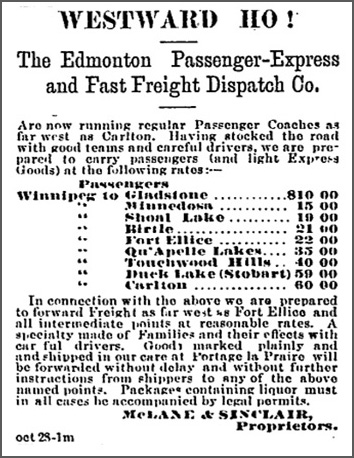 6-Jan,
1881 -
Winnipeg
Times
6-Jan,
1881 -
Winnipeg
Times
Another article on February 1 in the same paper offers a small glimpse
of the
future. Under the heading "Western Division" a C.P.R. ad
informs us of daily train service to and from Portage. In an
interesting aside, we are told that the trains "are run by St. Paul
time, which is seventeen minutes faster that Winnipeg time." (3) That
Canadian invention, Standard Time would soon solve the problem of each
settlement having its own time.
Also in that Feb. 1 paper the "Western Mails" column show that the
route serving our area is as follows: Minnedosa, Odanah, Salisbury,
Rapid City, Grand Valley." Although Grand Valley is on the mail route,
it is on an offshoot of the main line which runs along a fork in
the Carleton Trail.
So in the winter and early spring of 1881 we see only hints
of the
changes that were taking place in terms of settlements, Post Offices
and routes. Hindsight allows us to see the occurrences in these few
months
as what we might now term a paradigm shift in settlement patterns all
hinging on the C.P.R. decision to follow a much more southerly
route to the Rockies, which would soon be followed by the choice of the
exact location of the necessary Assiniboine crossing.
As yet there was only speculation of a change in the line. But the
champions
of the earlier, more northerly C.P.R. route did not take such
speculation lying down. A Birtle resident sent a long letter
to the Winnipeg
times stating thet. It is believed to be the intention of the Syndicate
to deflect the line... south of the Assiniboine." and goes on to
advance the argument that such a most would be reckless because that
river, "forms a capital line of defence, and a serious obstacle to an
invading force." (4) Thus the
line, for safety's sake, should be north of
that admirable line of defence. One suspects the the writer,
identified only as "Veteran" was overstating his case just a bit.
What we can see is that by the end of March, 1881, something was in the
air. Discussion was taking place, and decisions would soon be made that
would alter the future of settlement and commerce in western Manitoba.
In searching through news
reports from 1880 that mention happenings in
what we now call Westman, we, of course, find no mention of the city of
Brandon. In fact we see no real hints that anyone even anticipated the
establishment of a town on this site, or even in the area. As we
look at the beginning of 1881, our earlier impression that Rapid City
would be the future urban centre of the region are confirmed. As well
we note that although the first settlers in the little frontier
settlements in western
Manitoba may have felt far removed from the heart of Canada, but
their efforts at bringing a little civilization this wild land being
noticed "back home".

April 1881
The
month of April, 1881, which was to become,
in hindsight, such an important month for the future city of Brandon,
was quite quiet in terms of
newpaper articles. But the
news that did appear in the papers turned out to be quite
important.
The
Toronto Daily Mail, under the
heading, "Manitoba Notes" (1) a survey
of news from western province,
datelined April 5, has picked up the story that
"General Rosser, chief engineer of the Canadian Pacific railway, has
returned from locating the second hundred miles west, and has
instructed the district engineer to direct the main line some distance
east of the terminus a hundred miles, so as to run south-westerly
toward the Assiniboine, and cross near the rapids of that river."
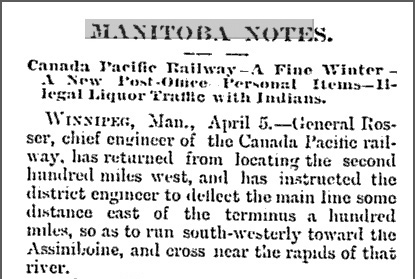 5-April,
1881 - Toronto Daily Mail
5-April,
1881 - Toronto Daily Mail
The rapids, then known as the Grand Rapids, but soon to be known as the
Brandon Rapids, are a few kilometres downstream from today's Brandon.
If you drive east on Richmond Avenue as far you can, walk down to the
river bank and look south, you will be looking at the very beginnings
of those rapids. It is clear from this article that the exact site of
the future crossing has not been chosen, but that article and the
rumours that would certainly have accompanied it, would have
caught the interest of settlers, or anyone with an interest in
speculating in the region.
This would appear to confirm the worst fears of settlers along the
Carleton Trail. The railway that they felt was coming their way would
bypass them. Their loss would mean an opportunity for settlers and
landowners along the newly announced southern route.
Also in that roundup of Manitoba news we learn that, "A new post-office
is to be opened after the first of May at section 9, in the township of
Range 17 west to be called Eleton. It is in the neighbourhood of Grand
Valley, and will receive regular mail service from that post-office.
I'm not sure if the spelling of Elton is a misprint or if it was
changed later but 1884 listing of Manitoba Post offices has it as
Elton. The mention of it hints at a steady, if modest increase in
settlement.
Buried in the third paragraph of an article in the Toronto Daily Mail (2)
(reprinted from the Winnipeg Times but based on "Cable news from
England") we learn that at a meeting of the shareholders of the
Canadian Pacific railway has announced that, "350 miles of railway west
of Winnipeg are expected to be in operation by the end of the present
year." and it later refers to "the crossing of the Assiniboine at Grand
Valley". We also learn that "General Rosser has just returned from a
reconnaissance of the proposed route for some distance west."
There was no doubt the
the immediate vicinity of our hometown was about
to become a more important place, but details remained sketchy, and the
exact location of the crossing was either not yet decided, or kept
secret.
It is worth pausing at this point to consider once again how unexpected
this series of events was, and just how empty the countryside was
around here.
The first settlers to western Manitoba came by three routes. Some came
up from St. Paul Minnesota on the Red River and took the Boundary
Commission trail westward from Emerson, where in succession communities
such as Manitou (originally Manitoba City), Crystal City and Wakopa
were founded.
Others took the Assiniboine, when the first steamboats ventured west of
Portage in 1879, and the community of Millford (3)
Many took the well-established Carlton Trail which ran from Winnipeg,
via Gladstone, through Minnedosa and on the Fort Ellice. The town of
Birtle (4) at the
crossing of the Birdtail River was also well established
by 1881. Offshoots of the Carleton Trail had earlier led settlers
to Rapid City, which by 1878 has become the commercial centre for the
district. That's were new settlers went for supplies.
And a few strayed southwards from that Carlton Trail, along a
branch that passed through Carberry, which had a few settlers by 1879,
with some making it as far as Grand Valley and the Brandon Hills before
selecting land.
Because it was an established fact that the railway would pass much to
the north the few settlers that did select this vicinity seemed to have
accepted that they would be on the frontier so to speak for some time.
No boom towns were advanced and it seemed as though the Grand Valley
and Brandon Hills settlements were in between the action spots. A short
report in a March edition of the Winnipeg Times outlines the Federal
Government plans to establish Land Title Offices to serve settlers in
the "north-west". These new facilities were to be located in
"the Turtle Mountain district one at either and Ellice or Bird
Tail Creek." (5)
At this time the first Land Titles office in the region was
already in operation near the mouth of the Souris River near Treesbank.
Grand Valley was in between these important establishments.
Ads like
the one posted in February of 1880 had reinforced the idea that the
route
would follow the established trail to Fort Ellice. Tenders were called
for construction of the line from, "near the western boundary of
Manitoba (at that time this was near Gladstone) to a point on the west
side of the valley of Bird Tail Creek. (Birtle) (6) It had seemed a done
deal.
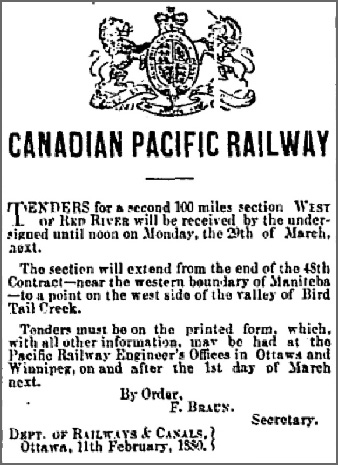 28-Feb,
1880 - Winnipeg Daily Sun
28-Feb,
1880 - Winnipeg Daily Sun
The announcement
that the a rail line, in fact the main rail line, now
was
coming this way, was a surprise. Some would say that was the whole
point. The C.P.R. and its operatives, General Rosser in particular it
seems, stood to make more money by opening up new towns rather than
visiting established ones. Whatever the motivation, the railway was
coming and excitement would follow.

May 1881
Although
Brandon still did not yet exist, one finds that from early May of 1881
there are news reports discussing the recent decision to
direct the C.P.R. line in a more southerly course and reviewing the
implications. On May 3rd the Times reports on "the decision of the
Canadian Pacific Railway Company to cross the Assiniboine at Grand
Valley". (1) The
lengthy article outlines the progress of
surveys and comments upon the wisdom of the choices made. No
news about the new crossing appears for over a week. But it was
certainly an important week.
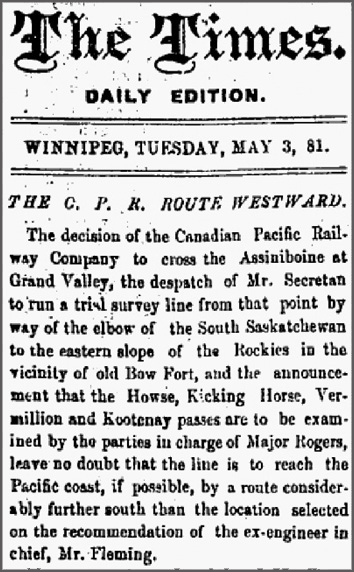 1-May,
1881
Winnipeg
Times
(Complete
article at bottom of this page.)
1-May,
1881
Winnipeg
Times
(Complete
article at bottom of this page.)
How was the decision made to locate the
station, and thus the town site
where Brandon sits today? Why was it not located on the site of Grand
Valley, an established steamboat landing and ferry crossing with a post
office, store and a few other facilities? There are two theories.
One is that physical aspect of Grand Valley was not
suitable. The river was high that spring and the Brandon site
offered a more secure location. The other story is that Dougald
McVicar, the owner of the Grand Valley site held out for a higher price
and Rosser, who intended to make a profit himself on the creation of
town sites, found a better deal upstream.
As we approach this crucial
turn of
events that would determine the
future of Brandon, it is worth looking at two written accounts that
didn't
appear in the newspapers at the time, but were in fact, eyewitness
accounts by men who had front row seats, so to speak.
Those two men were Beecham Trotter who was here at the time, working on
the railway, and James Secretan, the surveyor who worked with General
Rosser. I'll quote first from my earlier work on General Rosser: (2)
"The story of the
founding of
Brandon has often
been told, in its various
and conflicting forms. Where does fact give way to legend? Do we
believe
Mrs. Dougald McVIcar. sister-in-law of the Grand Valley property owner,
who
makes no mention of Rosser’s offer to purchase the town site. [1]
How reliable
are the various other accounts that have McVicar falling victim of bad
advice
from cronies? What about Brandon pioneer Beecham Trotter’s
account wherein
McVicar immediately asks for double what Rosser was willing to pay,
only
to be stung by Rosser’s, equally quick reply, ”I’ll
be damned if a town of
any kind is ever built here.” [2] The most reliable account may
be found
in the memoirs of James Secretan, a C.P.R. surveyor who worked with
Rosser.
He recalls that Rosser in fact made a $50000 offer, and when McVicar
did
counter
with a request for $60000, the General abruptly ended negotiations and
moved
on upstream. [3]"
It is possible that it
was in
that first week of May
that General Rosser had his famous conversation with Mr. McVicar (If
indeed Mr. McVicar was the un-named landowner Mr. Secretan
describes.), thus sealing the fate of the town of Grand Valley
and
opening up the possibility of the new city of Brandon. It could
be that this occurred earlier and was kept quiet for a month, or it
could have all happened on-the-fly so to speak.
Brandon historian Martin Kavanagh in "The Assiniboine
Basin", reports that:
"On May 3, 1881, J.W. Horne, a real
estate
broker, and at the same
time a representative of the
Manitoba and Northwest Mortgage Company, arrived.
J.W. Vaughn, the surveyor, came about May 9. He was evidently in
the company of Ross or Rosser, for he began his survey immediately.." P
153
On May 13 the Times reports that, "Gen. Rosser is laying out the
station grounds and Mr. Vaughn is surveying the town plot adjoining the
station at Grand Valley, the Canadian Pacific Railway crossing of the
Assiniboine."(3) A
few days later (May 16) they report
that the station will be on section 23, township 10, range 19. The
report
suggests that, "The syndicate intend to build repair shops at this
point which will make the town one of the most important on the line of
the C.P.R." (4) The
name Brandon has not yet been used, and on the
very next day large ads appear under headings such as, "The Grand
Valley
Crossing, site of the Great City of the C.P.R and crossing of the
Assiniboine River", and announcing that said town" has been located by
the Chief
Engineer of the C.P.R. on Section 23, Township 10, Range 19 West, On
the south-west side of the river". The ad continues in this vein making
it
clear the the C.P.R. station will be on the aforementioned site and
that .."Any other lots advertised are from two to three miles distant
from the station."(5)
This is a direct reponse to the continued efforts to promote the
original Grand Valley location. From the moment that the first reports
mentioned that the line would crossing the Assiniboine in the area
speculators had seized upon what they hoped was a golden opportunity.
Deals were made and the sell was on. In fact on the same page an ad
appears
selling lots at "Grand Valley"
calling it the "C.P.R. Crossing of the Assiniboine River, McVicar's
Landing, Grand Valley."(6) Another
ad, also on the same page,
appears for
McEneany & Curran's
City Tea Store, 225 Main St, and McVicar's Landing, Grand Valley."
Grand Valley hasn't given up the ghost just yet.(7)
All in all, this one page from a May 17 Winnipeg Times outlines
the situation. (16)
What the "Syndicate" that owned the
new town needed was a
way to define
themselves and their property, and they soon did. On another page
in that same edition we find a collection of brief
reports under the heading, "What is going on "round town" containing
these nuggets, one after the other: "A brick-yard is to be opened at
Grand Valley by McGerrigle and
Strachan." and, "Mr. Harvey goes west in a day or two to erect a hotel
at the new town
of Brandon." So the name "Brandon" is in use! (8)
If the name had already been chosen why wasn't it used in the ad?
The next day the name
appears again but this time far away in the
Toronto Daily Mail. They report that, "There is great excitement over
the new syndicate, at
Brandon, where the Pacific railway crosses the Assiniboine, some one
hundred and fifty miles west of Winnipeg. The survey is nearly
completed, the town lots will be on the martket next week. Industrial
enterprises have already begun, and stores have been opened as well as
hotels under canvas." (9)
Things are obviously moving along, and on May 22 we see the first large
display ads advertising, "The Town of Brandon. Grand Valley." (10)
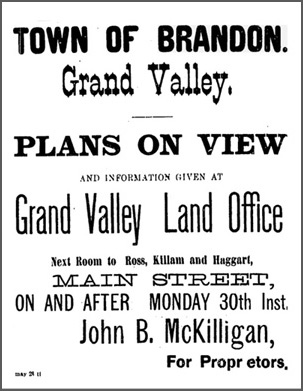 22-May,
1881
Winnipeg
Times
22-May,
1881
Winnipeg
Times
The issue would seem to have been settled.
The battle fought and won.
Brandon had a railways station and it would be the C.P.R. town. But
rumours will persist. The day after the first large display ad
mentioning "Brandon" appears, a letter to the
editor entitled "Latest C.P.R Rumors" provides another twist. It
advises us that, "..the Grand Valley boom may receive a cold water
bath." and goes on to outline a rumour to the effect that the C.P.R
hasn't settled the issue and that it may be planing a line from
Winnipeg, "south-west to the Pembina Mountains, thence west andfarther
on somewhat to the north-west, skirting the south borders of the Grand
Valley, and joining the main line somewhere in the Saskatchewan
country." It follows this up with other unsubstantiated rumours. (11)
On May 30 another ad runs offering lots in "Brandon, the C.P.R.
Crossing of the Assiniboine Rivers at Grand Valley" going on to extoll
its virtues as "The Future Great City" and reminding us that the the
site was , "Selected Located and Surveyed by the Chief Engineer of the
C.P.R." (12)
It was important that we know this. Across the province
extravagant claims were being made for sites that existed only on
paper.
All claimed to be the next big thing. Every one of them was sure to be
the next great railroad hub of the northwest. It may have been a bit of
a stretch to hail it the "Future Great City" but it was surveyed and it
did have a railway crossing. That was certainly more than was true of
places being promoted.
Still it was only and ad. They sometimes lied. But on May 25 a short
news article mentioned with very little fanfare that the steamer
Manitoba had arrived at noon and that "Among the passengers was A.H.
Vaughn, D.L.S., from Grand Valley with the plans of the new town of
Brandon at the railway crossing of the Assiniboine." (13)
Thw Toronto Daily Mail was a little less specific in reporting on May
28 that "there has been a great rush of settlers to Grand Valley, and
there is every prospect that it will continue for some time to come."(14)
For a summary we can turn again to Kavanagh's account.
He tells us that by May 28, the first load of lumber for the new
town was brought in by
Whitehead and
Myer on the steamer Northwest. The Coombs and Stewart store on the
northeast side of 6th &
Pacific (facing Pacific) had its tent replaced by rough boards from the
shipment. That the new city was somewhat lacking in services,
and was still
not firmly established in the minds of all is indicated by this little
report on May 30: "A stage line has been started between the Portage
and Grand Valley, making several trips a week." (15) Many who
read this at
the time still might not have fully understood
that while Grand Valley may still have been the terminus for both the
steamboats and this fledgling stage line, it was the new town of
Brandon that was the real destination for much of the traffic.
**For additional summaries by writers who were witnessing these events
check out the excepts from works by Carle, Macoun and Trotter at the
bottom of
this page.. (16)
near the
mouth of the
Souris, was well-established by 1880.

June
1881
For some
reason lirttle notice was taken of Brandon's growth in June of 1881.
But growth there was.
A news article from June 9 claims $25000 changed hands in 2
days. Those are 1881 dollars! The next item from June 22, advises
that "The Rapid City Landing Warehouse has been changed..." What has
happened is that Grand Valley - which had been a key hub for goods and
people going to Rapid City - has been bypassed and the new landing is
at the new town.
This may well have been primarily due to the flooding, but it also
signalled that the future was in Brandon.
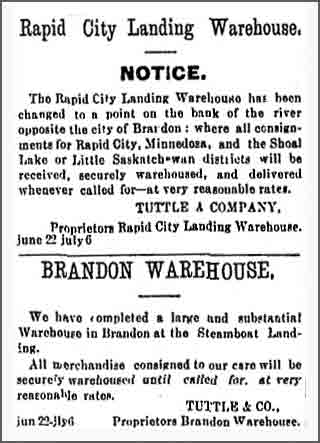 June
6, 1801. Brandin Sun
June
6, 1801. Brandin Sun
July 1881

Helpful
Local
Newspapers
The Winnipeg Daily Sun
The Brandon Sun Weekly
The Portage La Prairie Weekly
The Minnedosa Tribune
Available at:
www.manitobia.ca
The Winnipeg
Times
Available at:
www.paperofrecord.com
Print
Resources
Barker, G.F., Brandon: A City (Self-Published, 1977)
Berton, Pierre, The National Dream (Penguin Books Canada,1989)
Berton, Pierre, The Last Spike (Toronto: McLelland and Stewart
Ltd.,
1971)
Brown, Roy, The Brandon Hill
Connection,
(Tourism
Unlimited, Brandon MB.)
Brown, Roy, The Fort Brandon Story, (Tourism Unlimited, 158 8th St.
Brandon
Mb.)
Brown, Roy, Steamboats on the Assiniboine, (Tourism Unlimited, Brandon
MB)
Coates, Ken, and McGuiness, Fred, Manitoba : The Province and
People
(Hurtig Publishers, Edmonton, 1987)
Coates, Ken, and McGuiness, Fred, The Keystone Province : An
Illustrated
History of Manitoba Enterprise (Windsor Publications, 1988)
Fleming, Sandford, C.M.G., Report : Canadian Pacific Railway 1880,
(Ottawa,:
Maclean, Roger & Co.1880)
McVicar, Mrs. Dougald, Reminiscenses of early Brandon (Unpublished
Memoir,
1946)
Kavanagh, Martin, The Assiniboine Basin, (The Gresham Press, Old
Woking,
Surrey, England 1966 Ed.)
Secretan, J.H.E., Canada’s Great Highway: From the First Stake to
the Last
Spike (London, 1924)
Trotter, Beecham, A Horseman and The West (Toronto: Macmillan
Company
of Canada Ltd., 1925),
Welsted, John, Everitt, John, And Stadel,
Christoph : The Geography of Manitoba
: Its Land and People (University of Manitoba Press) |